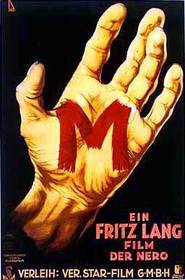Our editor-in-chief Nate Yapp is proud to have contributed to the new book Hidden Horror: A Celebration of 101 Underrated and Overlooked Fright Flicks, edited by Aaron Christensen. Another contributors include Anthony Timpone, B.J. Colangelo, Dave Alexander, Classic-Horror.com's own Robert C. Ring and John W. Bowen. Pick up a copy today from Amazon.com!
M (1931)
Fritz Lang's M is not, strictly speaking, a horror film. A simplistic identification for it would be crime drama, but M is not simplistic. Behind its single-letter title lies a wealth of complexities. Yes, in one way, it is a crime drama, but it's also a commentary on German society, a suspense thriller, and, in one sense, it's an incredibly unsettling horror story.
Mostly responsible for that horror is Peter Lorre, who plays a child murderer haunting Dusseldorf, Germany. The performance -- which is at turns grandiose, stricken, lascivious, and pathetic -- is not always the focus of the camera, but it is always the focus of the film. Even when Lorre is not on screen, his mannerisms and his horrible compulsions haunt the proceedings. After the film is over, he is still there, whistling into our ear.
Lang's film spends a great deal of the running time looking at how various elements of society conspire to capture and/or kill this abomination in their midst. The cops are overwhelmed by the populace who panic the moment a child is approached by any unknown person. They are heavily burdened in their search for the killer and they pass that burden onto the criminal organizations. The crooks in turn form their own search party, fearing equally for the children and their own livelihood.
Lang shows how these three parties -- the killer, the cops, and the crooks -- work with and against each other. Often when they are defying each other, they are also helping the other's needs. The killer unconsciously turns himself over to the crooks, but in doing so leads the cops straight to them later in the film.
This was Lang's first sound film, but it's unusual for an early talkie in that it's not constantly filled with chatter. M is a movie that knows when silence is more effective than noise, and when a simple whistle, bell, or bang will set the audience off more than words words words.
The director also experiments with pacing. Whereas conventional wisdom has the speed of a film pick up as it goes along, Lang reverses this. The film begins with many quick cuts and a lot of montage work, then slows down as the forces at work in the movie close in on their ultimate prey. The sets in M are all studio-bound, and it makes for a claustrophobic representation of a city. As the film progresses, the amount of time we spend in each location dilates while the spaces themselves become more compact. The feeling is one of inevitability; we are fated to either become a part of the cogwork of society or be ground to mash by those same cogs.
There are some brilliant subtextual touches here that show what can't be said. We never witness any overt violence. We instead see a little girl playing with a ball, who is then approached by Lorre (first shown in shadow). He buys her a balloon while her mother back home cries out for her desperately. Later, we see her ball roll unused into the dust and the balloon trapped in the power lines. This is no mere stand-in for a loss of life; it's also about a horrific loss of innocence.
Equally interesting is Lang's use of Grieg's "In the Hall of the Mountain King" from "Peer Gynt." This is the tune that Lorre whistles throughout the film whenever he is on the prowl. During the sequence where Lorre loses one girl to the arms of her mother, he quickly sits down at a café and tries desperately to calm down, ordering two cognacs. However, the whistling continues. At first the sound is strangled, but then it comes back in full force, and the murderer hunts for another victim that same night.
The whistling is a piece of Lang's attempt to bring the supernatural concept of the doppelgänger into the natural world. At alternate points in the film, Lorre seems to be both pleased with his actions and haunted by some exterior figure. There are multiple shots of Lorre looking into the mirror, and his reflection always seems disconnected. In his desperate plea for mercy before the court of criminals, he describes this presence in detail, but it's hard to separate how much is the truth and how much is simply a pathetic lie.
Since it bore many similarities to a recent serial killer spree, M was seen as a topical picture at the time of its release, the 1931 equivalent of a "Law & Order" episode. Today, however, the film is regarded as a masterpiece, and rightfully so. Lang's dedicated and complex work deserves accolades, as does Lorre's indelible, terrifying performance. M is one of the true masterworks of German cinema.









"M" is a horror movie, a
"M" is a horror movie, a thriller, and scary on many levels. The use of the ball rolling in the street and the balloon in the power lines still gives me chills. This movie stands the test of time.